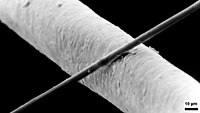
Photo from wikipedia
Abstracts Pineapple leaves are left as waste in many countries such as Thailand, Brazil, and the Philippines. However, due to its high cellulose content, it can be utilized as raw… Click to show full abstract
Abstracts Pineapple leaves are left as waste in many countries such as Thailand, Brazil, and the Philippines. However, due to its high cellulose content, it can be utilized as raw material for the synthesis of nanocelluloses (CNCs) using extraction. The mechanical properties were studied of reinforcing composite from pineapple leaves with and without fillers vulcanized using electron beam irradiation (EB) and sulfur vulcanization (S-vul). The extraction was performed using acid hydrolysis. The CNCs were rod-like in shape with a diameter and length of approximately 100–150 nm and 3–5 nm, respectively. The CNCs were used as reinforcing fillers in natural rubber (NR) composites. The results showed that loading CNCs at 2.5 phr in NR composites enhanced their mechanical properties due to the good distribution of the CNCs in the composites. Furthermore, the composites vulcanized using sulfur (S-vul) were stronger and had better chemical resistance than those using EB irradiation. This was related to the amount of crosslinking networks in the composites.
Journal Title: Materials today communications
Year Published: 2021
Link to full text (if available)
Share on Social Media: Sign Up to like & get
recommendations!